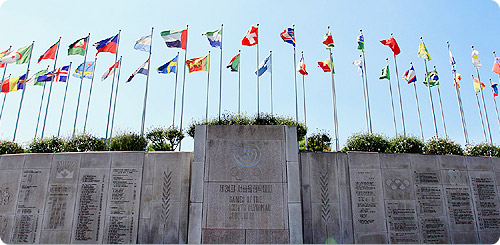Holy Land of Peace
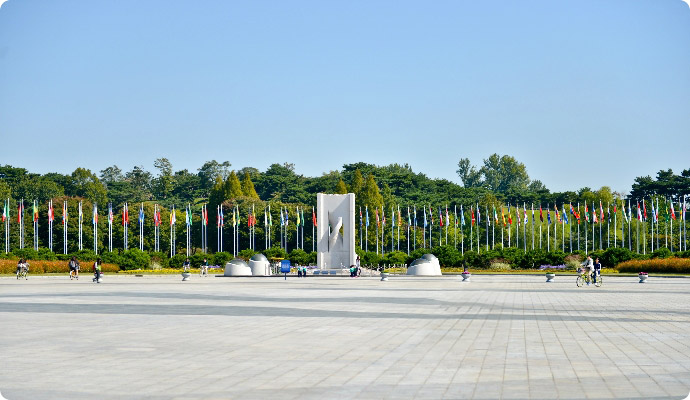
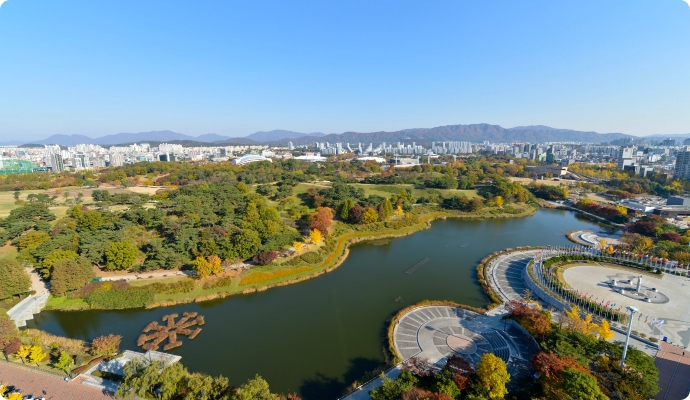
World Peace Gate
The 'World Peace th:Gate' constructed at the Peace Square within the Olympic Park located in Bangi-dong, Songpa-gu, Seoul, is a steel-reinforced concrete structure on a site area of 33,600㎡ (Width 80m, Length approx. 420m).With a maximum height of 24m, width (front & rear) of 37m, and surface length of 62m (front width of the wing), it presents a beautiful and solemn external appearance. The total area of the symbolic monument is 927㎡, consisting of 248㎡ basement level 1 and the 289㎡ deck level.
The 'World Peace Gate,' which attempted a natural harmony between traditional and modern architecture while portraying the gate concept optimally, utilized the curves of th:Korea's traditional architecture emphasizing the images of rapid progress and ascent.
On the lower part of the wing on the ceiling section of the monument, you can see a painting of the 4 gods, the Blue Dragon, Red Bird, White Tiger, and the Turtle Snake, on a single layer on both the 1,531m2 sides. This magnificent work was painted by a western painting artist of Korean origin, Geum-Nam Baek (Professor at Sungkyunkwan University) using the traditional Korean painting form with many colors as the dominant style.
On both sides of the World Peace Gate, 30 line pillar masks (made by sculptor Seung-Taek Lee) are erected to welcome the people. The masks made of bronze have a diameter of 60cm and a height of 85cm, and the line pillars made of stone have a diameter of 60cm and a height of 3m.

Peace Square
In front of the World Peace Gate the 28,000㎡ 'Peace th:Square' spreads wide, and the granite square features designs that are lookalikes of the hunting mural paintings recovered from a tumulus of the Goguryeo Dynasty. In the surroundings of the Square are the World Peace Gate, record monuments, a lake, and various amenities. The Square is the central section of the park and is being utilized diversely for onsite education, social sports, and as an area of culture and art for youths and citizens.

Declaration of Seoul Peace
Everyone desires to overcome the differences in ideology, race and religion, and escape from the threat of war and violence in order to live peacefully. This is because it is the way for people to truly enjoy their right to happiness, the common desire of mankind. As a result, in order for the 24th Summer Olympic Games in Seoul to be a festival of world peace in name and reality, the period from September 17 to October 2, 1988 was conceived as a period of peace, free from weapons, hatred, violence and terror. Those at the helm of hosting the Seoul Olympics thought of the event as the opportunity for world peace to take root eternally, and felt that this was the duty of all people worldwide toward human history.
Hence, the Declaration of Seoul Peace was adopted on September 12, 1988 at the Seoul Olympics based on the ideology in the Letter of Appeal for Peace that had already been signed by each and every one of us.

Stones of the World
Receiving a proposal from the IOC to construct a symbolic Olympic sculpture in January 1988, the Organizing Committee reached an agreement, and in February of the same year the Committee designated Prof. Choi, Ma-lin, and the IOC designated Subirachs, Josheph Maria from Spain as the artists for this task. In October of the same year both parties contributed $250,000 each, and at the square behind the World Peace Gate the main body with dimensions of 6.5m height and 3.2m width, and the 5 spheres with dimensions of 2.5m height and 2.4m width were formed with the names of the nations that donated 'the stones of the th:world' engraved and commemorated. On August 1989, the stone plate engraved with the construction purpose was installed, and on September 17 an unveiling ceremony commemorating the first anniversary of the Seoul Olympics was held.
The base of the sculpture was formed as a mosaic with about 4,000 natural stones of the world donated by the IOC, each NOC, and the athletes, and the contributors’ will was sublimated as a work of art.

-
- Olympic Center
- As the main headquarters of the Organizing Committees that conducted the preparations and operations for both the 10th Asian Games and the 24th Seoul Olympic Games, this is the place that holds memories of the sweat and efforts of the event operation officials.
-
- Total Floor Area: 17,305㎡ (2 floors below ground, 15 floors above ground)
- Construction Period: August 1984 ~ May 1986
- Features: The lower part of this building showcases the traditional beauty of Korean houses while the upper part presents a modern touch.
- Construction Cost: 10.8 billion Won (donated by the Seoul Olympic Games Korean-Japanese Sponsorship Association)
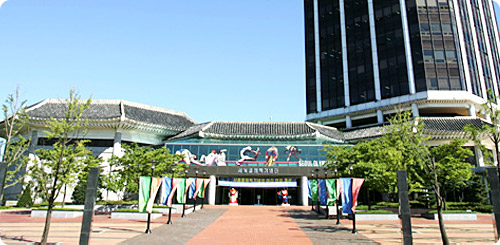
-
- Torch of Peace
-
The Torch of Peace installed at the center of the World Peace Gate was produced on the recommendation of the Seoul Olympic Peace Committee with funds provided by Seoul City, and construction of the monument was completed on August 31, 1988. The exterior of the torch is made of an octagonal granite sculpture measuring 4.1m in diameter and 0.75m in height and uses city gas for fuel. The design work was headed by Kwak Yeong-hun, director of the Korea Environment Institute of Environment Group Inc.
-
At the base of the Torch of Peace monument, the 'Declaration of Seoul Peace,' the purpose of installing the Torch of Peace, and the process of lighting and relaying the torch are engraved in three languages - Korean, English, and French. Supported by the organizing committee, the fire brought from Chamseongdan in Mt. Manisan , Ganghwa-do on September 12, 1988 was ignited jointly by Mr. Samaranch, Chairman of IOC, and Mr. Seok-Heon Ham, Head of the Seoul Olympic Peace Committee, and this sacred torch was donated to the Organizing Committee by the Seoul Olympic Peace Committee.
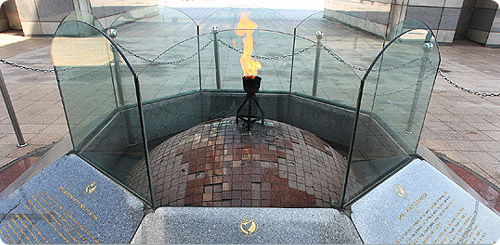
-
- Wall of Glory
-
In order to decide on the scope of details to be recorded on the monument, the Organizing Committee formed a record compilation sub-committee and a deliberation sub-committee holding the first meeting in February 1988, and a joint compilation & deliberation meeting was held in March to discuss issues relating to Olympic bidding, results outline, and record materials etc. Along with this, the artistic results and the writings themselves were also discussed in detail and confirmed.
The inscription works were completed on August 15, 1989, and the entire construction was finalized on August 30. The records were allocated in a balanced fashion from the left to right of the stone wall and they include the dedication poem 'Oh My Great th:Nation' by the poet Byeong-Hwa Jo, factual records of the Olympics bid, event operation, circumstances, significance etc., as well as names of contributors, donating individuals and organizations. In March 1988 the Organizing Committee entered the wall painting agreement with Ante Glibota, an International Working Committee member for the World Contemporary Art Festival, and in September of the same year the wall paintings by the French artist, jean Messagier, and the American artist, Elizabeth Frazheim, were installed in 2 places left and right of the Water Stage. This wall painting, which used iron and enamel, is 67.5m in width and 2.2m in height. -
- Total Floor Area: 17,305㎡ (2 floors below ground, 15 floors above ground)
- Construction Period: August 1984 ~ May 1986
- Features: The lower part of this building showcases the traditional beauty of Korean houses while the upper part has a modern touch to it.
- Construction Cost: 10.8 billion Won (donated by Seoul Olympic Games Korean-Japanese Sponsorship Association)
